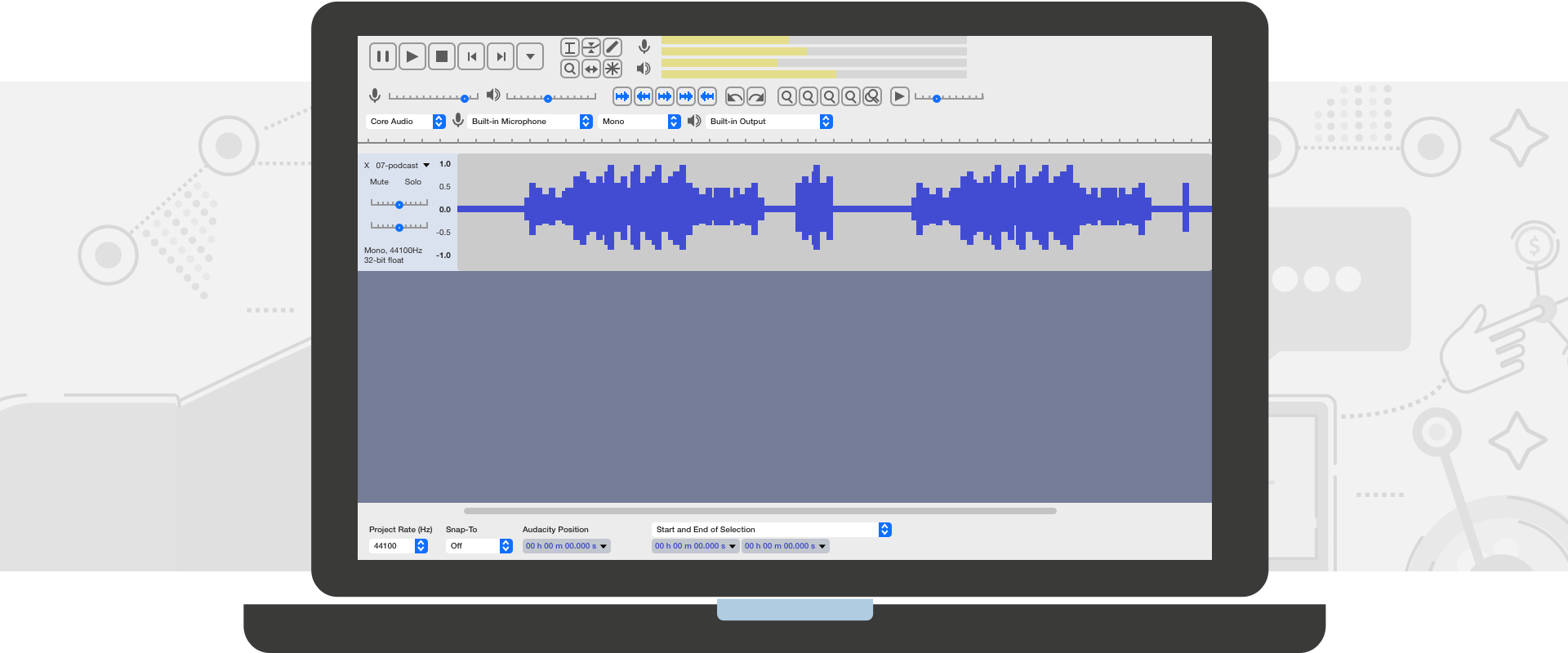
- #AUDACITY AUDIO EDITOR TUTORIAL HOW TO#
- #AUDACITY AUDIO EDITOR TUTORIAL SOFTWARE#
- #AUDACITY AUDIO EDITOR TUTORIAL TRIAL#
- #AUDACITY AUDIO EDITOR TUTORIAL FREE#
While we have the track selected, lets also go ahead and normalize since we added an effect. This will remove all the background noise from your track. Now select the whole track with ctrl and a, and hit noise reduction and ok again. Now Audacity has a profile of what our background noise sounds like. From there we can hit get noise profile, and ok. To remove background noise, we are going to select that empty space and click noise reduction. This effect is why we left empty space in our audio. This is a good effect to run every time you add a different effect, to make sure your audio is consistent even if you’ve edited various portions of it.Īnother important effect is noise reduction, which we can use to remove background noise from our audio. One of the most important effects to be aware of is normalize, which sets the peak amplitude of all tracks so they match up. You also use the selection tool to select specific areas for audio effects. To use it, you just click and drag to select an area, and then you can delete it with the delete key. The selection tool is key for cutting out dead air, or removing filler words. If you have multiple audio clips on the timeline, you can use this tool to drag them around so that they play earlier or later. The next important tool for simple editing is the time shift tool. Notably, if you set up your microphone properly, you won’t have to use this tool much since the volume will already be where you want it, but this tool can still be useful for touching up occasional loud spots, or if your microphone settings are imperfect. So as we close the tool in here, you can see audio levels change to fit inside. This tool lets you control how loud the volume at a certain portion of the track can be. There are a few tools you should be aware of when editing. The stop button, on the other hand, is what we use to stop recording all together, so once you finish what you want to record, you’ll use that button to end the recording. So if you’re in the middle of recording, and you get a phone call, you can use the pause button to make sure you don’t lose your place. The pause button lets us temporarily stop recording, and then we can pick right back up with the play button. While recording there are three buttons you should be aware of. I’ll explain why you want that empty space in a bit. You want to be sure to leave a small delay at the beginning of the recording, or at the end. To do so, you just hit the red button and start talking. Once you have that figured out, you can delete your test recordings by pressing ctrl and a, and then pressing the delete key.

#AUDACITY AUDIO EDITOR TUTORIAL TRIAL#
It might take some trial and error to find exactly the right recording volume for your microphone.


So we can stop, increase the volume, and try again. This is going to determine how loud the audio you record is going to be, so if we hit record, you can see it’s kind of quiet as the sound waves are very small. You are just going to want to set your recording volume first. Once you have your basic settings ready to go, you’re almost ready to record. These are some advanced settings that you don’t need to touch. There are also a number of settings on the bottom, including project rate and snap to. For most of you it will be 2, but if you have an XLR microphone it may be 2. You may also need to change the number of recording channels. You can pick your speaker in the same way, but from this other dropdown. This one lets you select your microphone, I have a few options, but I’m going to pick the blue yeti, since that’s my main microphone. You can do that from these two dropdowns. First you are going to want to set up your microphone and speaker. I’m not going to go over every tool the program has to offer, but I will go over the essential tools you’ll need to record and edit audio.
#AUDACITY AUDIO EDITOR TUTORIAL SOFTWARE#
If you are interested in more software tutorials, consider subscribing to TrustRadius to make sure you never miss a video. I use audacity to edit sound for videos, but you can also use it for music, podcasts, and any other audio you need to record and edit. Hello, I’m Brian, a researcher at TrustRadius, and today I’m going to explain basic editing with Audacity.
#AUDACITY AUDIO EDITOR TUTORIAL HOW TO#
This video will cover the basics of how to edit with Audacity, to get you started and save you some trial and error. Because Audacity offers so many advanced features for music editing, it can be intimidating for users that just want to make some simple touch-ups or cuts to an audio file. Though it was designed to be used to edit music, it’s also a strong tool for editing podcasts, sound for videos, and more.
#AUDACITY AUDIO EDITOR TUTORIAL FREE#
Audacity is a free to use sound editing software.


 0 kommentar(er)
0 kommentar(er)
